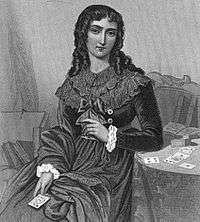Marie Anne Lenormand
Marie Anne Adelaide Lenormand (1772–1843) was a French professional fortune-teller of considerable fame during the Napoleonic era. In France, Lenormand is considered the greatest cartomancer of all time, highly influential on the wave of French cartomancy that began in the late 18th century.
Marie Anne Lenormand | |
|---|---|
 | |
| Born | Marie Anne Adelaide Lenormand 27 May 1772 Alençon, Normandy, France |
| Died | 25 June 1843 (aged 71) Paris, Île-de-France, France |
| Nationality | France |
| Occupation | Fortune teller, writer |
| Parent(s) | Jean Louis Antoine Lenormand, Marie Anne Lenormand (née Gilbert) |
Early life
Lenormand was born on 27 May 1772 in Alençon, Normandy, to Jean Louis Antoine Lenormand, a draper, and Marie Anne Lenormand (née Gilbert). Lenormand was orphaned at the age of five and educated in a convent school. Lenormand left Alençon for Paris in 1786.[1]
Career
Lenormand claimed to have given cartomantic advice to many famous persons, among them leaders of the French revolution (Marat, Robespierre and St-Just), Empress Josephine and Tsar Alexander I. She was active for more than 40 years.
In 1814 Lenormand started a second literary career and published many texts, causing many public controversies. She was imprisoned more than once, though never for very long.
Death
Lenormand died in Paris on 25 June 1843 and is buried in Division 3 of Père Lachaise Cemetery.[2][3] She left behind a fortune of 500,000 Francs, and left no heirs other than a nephew who, at the time of her death, was in the army.[4] A devout Catholic, her nephew burned all of Mme. Lenormand's occult paraphernalia; taking only the monetary fortune that she left behind.
Works
- Les souvenirs prophétiques d'une sibylle sur les causes secrétes de son arrestation - Paris (1814) (592 pages)
- Anniversaire de la mort de l'impératrice Josephine (1815)
- La sibylle au tombeau de Louis XVI (1816)
- Les oracles sibyllins ou la suite des souvenirs prophétiques - Paris (1817) (528 pages)
- La sibylle au congrès d'Aix-la-Chapelle (1819) (316 pages)
- Mémoires historiques et secrets de l'impératrice Joséphine, Marie-Rose Tascher-de-la-Pagerie, première épouse de Napoléon Bonaparte - Paris (1820) (556 pages)
- Mémoire justificatif présenté par Mlle Le Normand (1821) (20 pages)
- Cri de l'honneur (1821) (18 pages)
- Souvenirs de la Belgique - Cent jours d'infortunes où le procès mémorable (1822) (416 pages)
- L'ange protecteur de la France au tombeau de Louis XVIII (1824)
- L'ombre immortelle de Catherine II au tombeau d'Alexandre Ier (1826)
- L'ombre de Henri IV au palais d'Orléans (1830) (107 pages)
- Le petit homme rouge au château des Tuileries - Paris (1831) (107 pages)
- Manifeste des dieux sur les affaires de France (1832) (60 pages)
- Arrêt suprême des dieux de l'Olympe en faveur de Mme. la duchesse de Berry et de son fils (1833) (144 pages)
Possibly author of
- Histoire de Jean VI. de Portugal, depuis sa naissance jusqu'à sa mort en 1826. - Paris : Ponthieu, 1827
Lenormand cards
After Lenormand's death her name was used on several cartomancy decks including a deck of 36 illustrated cards known as the Petit Lenormand or simply Lenormand cards still used extensively today.[5] The 36 card Lenormand deck is modelled on a deck of cards published ca.1799 as part of Das Spiel der Hoffnung (The Game of Hope), a game of chance designed by Johann Kaspar Hechtel of Nuremberg.[6][7][8][9][10]
In popular culture
Lenormand appears as a character in the video game Assassin's Creed Unity.
Lenormand's reincarnated soul is a character in the novel Waiting for Gertrude: A Graveyard Gothic by Bill Richardson.
References
- Decker, Ronald; Depaulis, Thierry; Dummett, Michael (1996). A Wicked Pack of Cards: The Origins of the Occult Tarot. London: Gerald Duckworth and Company. p. 119. ISBN 9780715627136.
- Decker, Ronald; Depaulis, Thierry; Dummett, Michael (1996). A Wicked Pack of Cards: The Origins of the Occult Tarot. London: Gerald Duckworth and Company. p. 132. ISBN 9780715627136.
- "Marie Anne Lenormand". Find A Grave. Retrieved 11 September 2012.
- The Illustrated London News, 1 July 1843.
- "What is Lenormand?". Cafe Lenormand. Retrieved 23 January 2018.
- Hoffmann, Detlef; Kroppenstedt, Erika (1972). Wahrsagekarten: Ein Beitrag zur Geschichte des Okkultismus. Bielefeld: Deutsches Spielkarten Museum. pp. 17, 21.
- O'Donoghue, Freeman Marius (1901). Catalogue of the Collection of Playing Cards Bequeathed to the Trustees of the British Museum by the late Lady Charlotte Schreiber. London: British Museum.
- Decker, Ronald; Depaulis, Thierry; Dummett, Michael (1996). A Wicked Pack of Cards: The Origins of the Occult Tarot. London: Gerald Duckworth and Company. pp. 141, 282. ISBN 9780715627136.
- Humoristische Blätter für Kopf und Herz. Nuremberg: Gustav Philipp Jakob Bieling. 1799.
- Will, Georg Andreas; Nopitsch, Christian Conrad (1805). Nürnbergisches Gelehrten-Lexicon: Sechster Theil von H-M. Altdorf bei Nürnberg.
External links
- Trionfi: Biography of Marie Anne Adelaide Lenormand by autorbis
- Trionfi Museum: Fortune telling decks including Lenormand decks
- Lenormand Museum: Online museum displaying a private collection of Lenormand decks
- Remarkable women of different nations and ages: Mademoiselle Lenormand; the Fortune Teller (John P. Jewett and Company, Boston 1858)
- The Court of Napoleon by Frank Boott Goodrich (Derby and Jackson, New York 1858)
- Madame Lenormand, the most famous card reader of all time by Mary K. Greer
- Origins of Playing Card Divination by Mary K. Greer